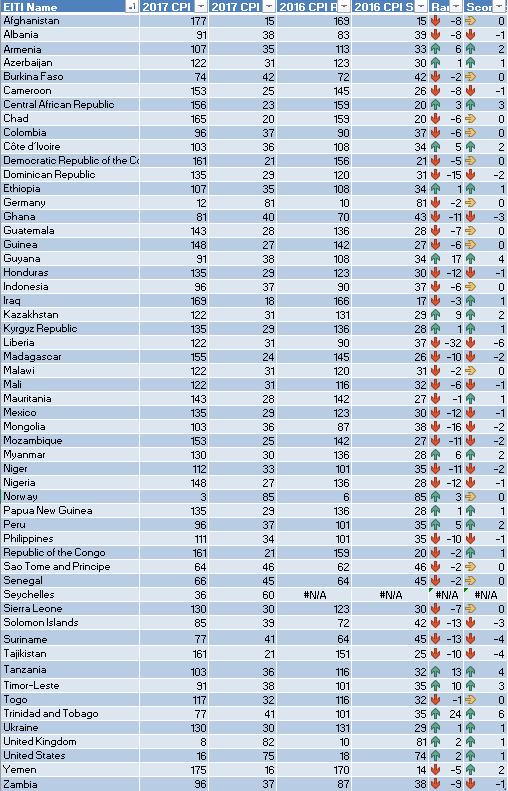
Transparency International (TI) has released its annual Corruption Perceptions Index (CPI) for 2017. The Index is of great interest to extractive sector followers and the EITI.
Unfortunately, the global picture is pretty dismal. This year’s Corruption Perceptions Index highlights that the majority of countries are making little or no progress in ending corruption. Sadly this seems particularly true of countries with a significant extractives sector. Amongst the largest oil-producers in the world, only four (Canada, Norway, UK and US) scored above 70 on the corruption perceptions index.
Digging in to the data

Relationship between the CPI and RGI’s Extractive Sector Governance indicator.
The Natural Resource Governance Institute (NRGI) has looked at the relationship between extractive sector transparency and accountability by comparing the results in their Resource Governance Index, and this year’s CPI results. The results show that there is a clear correlation between lower levels of transparency in the extractives and higher levels of corruption. The results also show that improving extractive governance has positive spillover effects beyond the management of natural resources.
There is a clear lesson – there is still much to do to tackle corruption, especially in the extractives sector.
EITI and the CPI - A Norwegian-Afghan sandwich
At the country level, EITI countries are spread in the CPI all the way from Norway at no 3, the highest ranked EITI country, to Afghanistan, the lowest at 177. Several EITI countries have made significant jumps in the past five years. Myanmar has improved its score by 15 since 2012, due in part to the government’s reform agenda. Elsewhere in Asia, Timor-Leste increased its score enough to rank in the top 100 for the first time. In Africa, Senegal too has increased its score by nine points since 2012 which, along with Cote d’Ivoire, has been carrying out long-term anti-corruption agendas. The United Kingdom has also improved its score by eight – thanks in part to its beneficial ownership register, one of the first in the world and a model for other EITI countries. Guyana, which joined the EITI last year, has also increased its score by ten points since 2012. Trinidad and Tobago, a long-time member of the EITI, achieved its highest score to date on the CPI. Peru, in the same region, has similarly improved.
CPI and EITI Validations are complementary tools for assessing good governance
The CPI is based on perceptions of corruption. In many cases the public perceives that corruption is happening but has no firm evidence. EITI data brings credible and verified evidence of how the sector is managed and provides recommendations for improvements. EITI membership offers a shielding mechanism against the general tendency of mineral-rich countries to experience increases in corruption over time[1]. A paper from 2016 finds that EITI implementation has a number of positive effects on a country’s economic and political environment, including increased credit ratings and political stability[2].
As EITI Chair, Fredrik Reinfeldt, says in this year’s EITI Progress Report “The EITI’s mission is to strive for a world where leaks are redundant because information is readily available”. The same could be said about the EITI striving to reduce space for corruption. This year’s CPI reminds us of the size of the job and the number of tools needed.

Click on the table to see a larger version or access the table here.
[1] Elissaios Papyrakis, Matthias Rieger & Emma Gilberthorpe (2016) Corruption and the Extractive Industries Transparency Initiative, The Journal of Development Studies, 53:2, 295-309,
[2] Claussen, Christoffer Borchgrevink (2016). A Cure for the Curse? Effects of the Extractive Industries Transparency Initiative. University of Oslo, Oslo.



